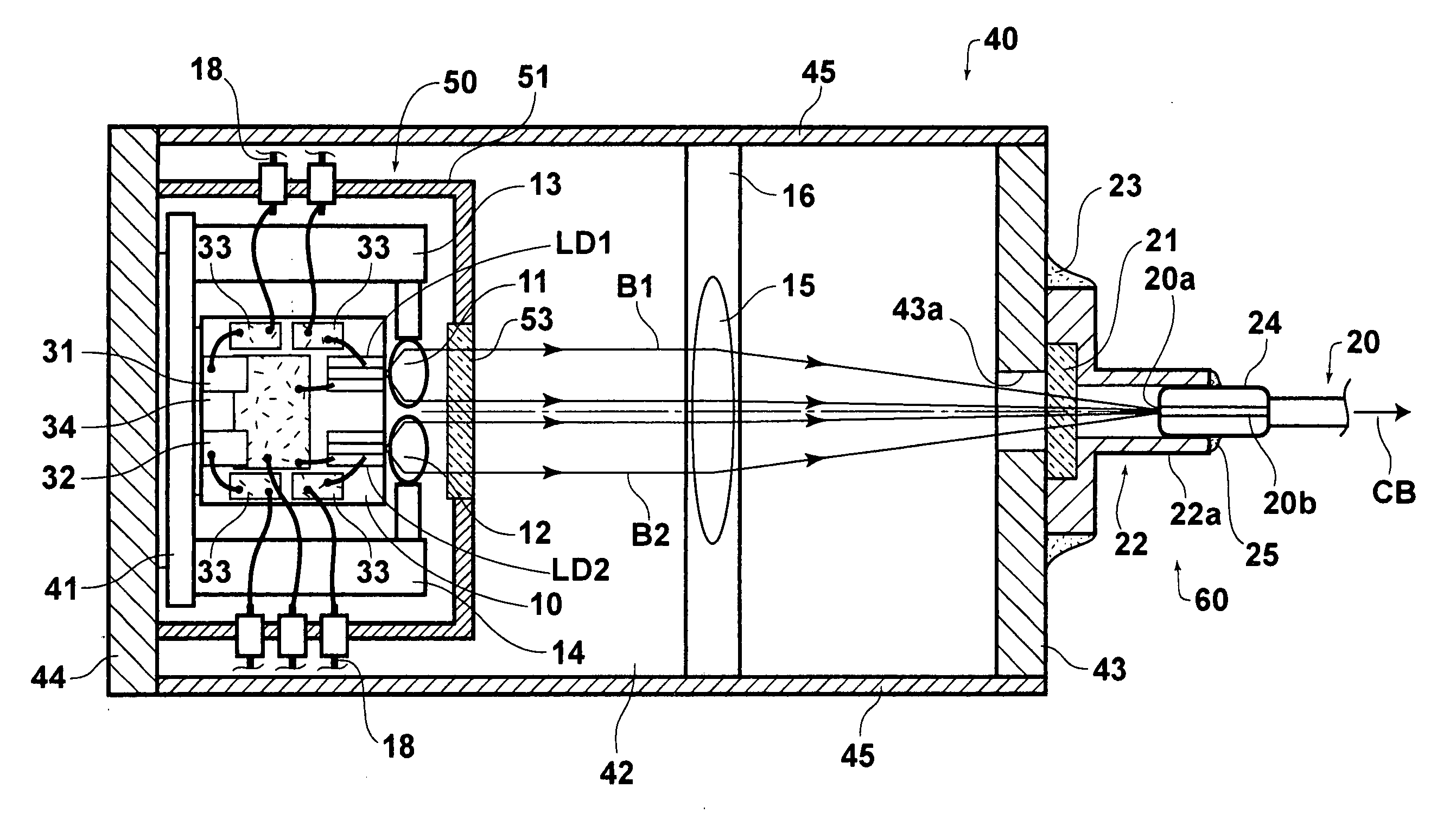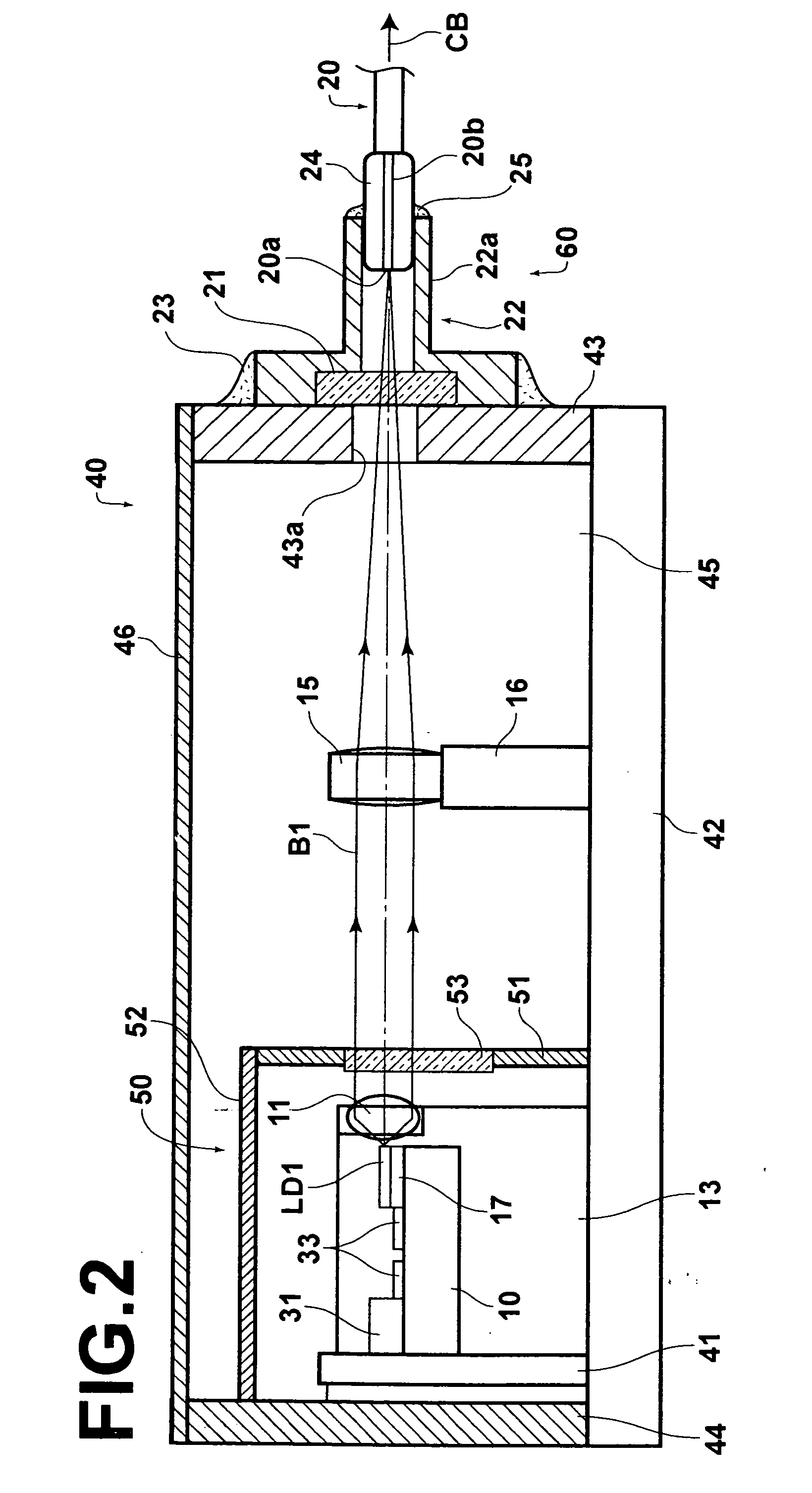Laser module with sealed package containing limited optical components
- Summary
- Abstract
- Description
- Claims
- Application Information
AI Technical Summary
Benefits of technology
Problems solved by technology
Method used
Image
Examples
first embodiment
[0070]FIGS. 1 and 2 are respectively plan and side views, partly in cross section, of a laser module according to the first embodiment of the present invention.
[0071] As illustrated in FIGS. 1 and 2, the laser module according to the first embodiment comprises a plurality (e.g., two) of semiconductor lasers LD1 and LD2, a heat block (heat-dissipation block) 10, a plurality (e.g., two) of collimator lenses 11 and 12, a plurality (e.g., two) of collimator-lens holders 13, and 14, a condensing lens 15, a condensing-lens holder 16, and an optical fiber 20. The semiconductor lasers LD1 and LD2 are fixed on the upper surface of the heat block 10. The collimator lenses 11 and 12 collimate divergent laser beams B1 and B2 emitted from the semiconductor lasers LD1 and LD2. The collimator-lens holders 13 and 14 respectively hold the collimator lenses 11 and 12. The condensing lens 15 condenses the collimated laser beams B1 and B2 so that the laser beams B1 and B2 converge at an identical posi...
second embodiment
[0113] Hereinbelow, the second embodiment of the present invention is explained with reference to FIG. 3, which is a plan view, partly in cross section, of a laser module according to the second embodiment of the present invention.
[0114] The laser module according to the second embodiment is basically different from the first embodiment in that magnifying condenser lenses 61 and 62 are used instead of the collimator lenses 11 and 12 and the condensing lens 15, and the light-source package 50 contains the semiconductor lasers LD1 and LD2 and the magnifying condenser lenses 61 and 62. In addition, in the second embodiment, the photodiodes 31 and 32, which are arranged in the first embodiment for monitoring the backward emission light, are not used.
[0115] As illustrated in FIG. 3, in the laser module according to the second embodiment, the laser beams B1 and B2 emitted from the semiconductor lasers LD1 and LD2 are respectively collimated by the magnifying condenser lenses 61 and 62, ...
third and fourth embodiments
[0176] The one or more semiconductor laser elements used in the present invention may be realized by an array of single-cavity semiconductor laser elements, or a single multi-cavity semiconductor laser element (LD bar), or an array of multi-cavity semiconductor laser elements, or a combination of at least one single-cavity semiconductor laser element and at least one multi-cavity semiconductor laser element.
[0177]FIG. 9 is a plan view of a portion of a laser module according to the third embodiment of the present invention. In the laser module according to the third embodiment, as illustrated in FIG. 9, eight semiconductor laser elements are stacked in upper and lower layers. Specifically, four semiconductor laser elements LD11, LD12, LD13, and LD14 are arranged along the horizontal direction in the upper layer, and four semiconductor laser elements LD21, LD22, LD23, and LD24 are arranged along the horizontal direction in the lower layer.
[0178] Divergent laser beams B11, B12, B13,...
PUM
 Login to View More
Login to View More Abstract
Description
Claims
Application Information
 Login to View More
Login to View More - R&D
- Intellectual Property
- Life Sciences
- Materials
- Tech Scout
- Unparalleled Data Quality
- Higher Quality Content
- 60% Fewer Hallucinations
Browse by: Latest US Patents, China's latest patents, Technical Efficacy Thesaurus, Application Domain, Technology Topic, Popular Technical Reports.
© 2025 PatSnap. All rights reserved.Legal|Privacy policy|Modern Slavery Act Transparency Statement|Sitemap|About US| Contact US: help@patsnap.com



